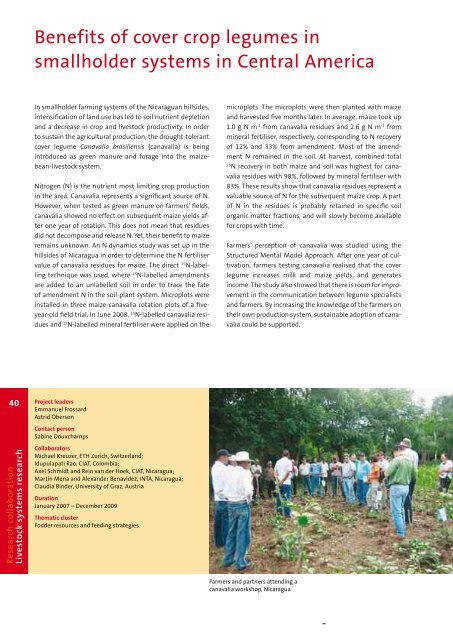NORTH-SOUTH CENTRE - ETH - North-South Centre North-South ...
NORTH-SOUTH CENTRE - ETH - North-South Centre North-South ...
NORTH-SOUTH CENTRE - ETH - North-South Centre North-South ...
Create successful ePaper yourself
Turn your PDF publications into a flip-book with our unique Google optimized e-Paper software.
Benefits of cover crop legumes in<br />
smallholder systems in Central America<br />
In smallholder farming systems of the Nicaraguan hillsides,<br />
intensification of land use has led to soil nutrient depletion<br />
and a decrease in crop and livestock productivity. In order<br />
to sustain the agricultural production, the drought-tolerant<br />
cover legume Canavalia brasiliensis (canavalia) is being<br />
introduced as green manure and forage into the maizebean-livestock<br />
system.<br />
Nitrogen (N) is the nutrient most limiting crop production<br />
in the area. Canavalia represents a significant source of N.<br />
However, when tested as green manure on farmers’ fields,<br />
canavalia showed no effect on subsequent maize yields after<br />
one year of rotation. This does not mean that residues<br />
did not decompose and release N. Yet, their benefit to maize<br />
remains unknown. An N dynamics study was set up in the<br />
hillsides of Nicaragua in order to determine the N fertiliser<br />
value of canavalia residues for maize. The direct 15 N-labelling<br />
technique was used, where 15 N-labelled amendments<br />
are added to an unlabelled soil in order to trace the fate<br />
of amendment N in the soil-plant system. Microplots were<br />
installed in three maize-canavalia rotation plots of a fiveyear-old<br />
field trial. In June 2008, 15 N-labelled canavalia residues<br />
and 15 N-labelled mineral fertiliser were applied on the<br />
microplots. The microplots were then planted with maize<br />
and harvested five months later. In average, maize took up<br />
1.0 g N m -2 from canavalia residues and 2.6 g N m -2 from<br />
mineral fertiliser, respectively, corresponding to N recovery<br />
of 12% and 33% from amendment. Most of the amendment<br />
N remained in the soil. At harvest, combined total<br />
15<br />
N recovery in both maize and soil was highest for canavalia<br />
residues with 98%, followed by mineral fertiliser with<br />
83%. These results show that canavalia residues represent a<br />
valuable source of N for the subsequent maize crop. A part<br />
of N in the residues is probably retained in specific soil<br />
organic matter fractions, and will slowly become available<br />
for crops with time.<br />
Farmers’ perception of canavalia was studied using the<br />
Structured Mental Model Approach. After one year of cultivation,<br />
farmers testing canavalia realised that the cover<br />
legume increases milk and maize yields, and generates<br />
income. The study also showed that there is room for improvement<br />
in the communication between legume specialists<br />
and farmers. By increasing the knowledge of the farmers on<br />
their own production system, sustainable adoption of canavalia<br />
could be supported.<br />
40 Project leaders<br />
Emmanuel Frossard<br />
Astrid Oberson<br />
Contact person<br />
Sabine Douxchamps<br />
Research collaboration<br />
Livestock systems research<br />
Collaborators<br />
Michael Kreuzer, <strong>ETH</strong> Zurich, Switzerland;<br />
Idupulapati Rao, CIAT, Colombia;<br />
Axel Schmidt and Rein van der Hoek, CIAT, Nicaragua;<br />
Martin Mena and Alexander Benavidez, INTA, Nicaragua;<br />
Claudia Binder, University of Graz, Austria<br />
Duration<br />
January 2007 – December 2009<br />
Thematic cluster<br />
Fodder resources and feeding strategies<br />
Farmers and partners attending a<br />
canavalia workshop, Nicaragua
















